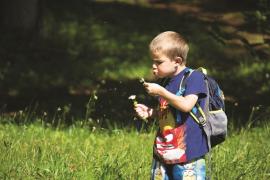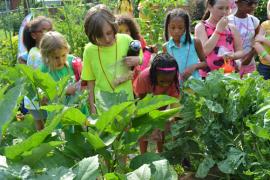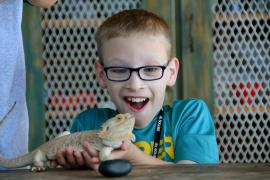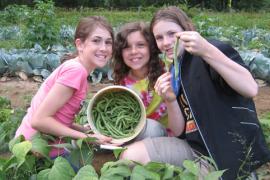Camps and stewardship education have gone hand-in-hand for decades. Leave No Trace, the best-known stewardship education program on US public lands, helps to make people a conservation solution through easy, actionable practices that reduce negative impacts. Leave No Trace is also closely tied to two areas of the American Camp Association (ACA)’s Youth Outcome Battery: “Affinity for Nature” and “Responsibility” (ACA, 2022). But Leave No Trace education is more than just looking at a list of principles as “rules of the outdoors.” In fact, it needs to be more to connect with today’s campers and staff. Let’s explore Leave No Trace through some new lenses that can help strengthen its positive effect in your programs.
“Now They Come Home and Clean After Meals!”
Parent phone calls and emails come in all shapes and sizes, but one shared sentiment stood out to me when I was on the leadership staff at McGaw YMCA Camp Echo. The comments often went something like this: “My child had the best time at camp — and now they help set the table and clean up after dinner without being asked! Thank you.” I always smiled at those remarks, but years later I still think back to why this was such important feedback. A value that we were intentionally fostering at camp (in this case, responsibility in our dining hall) was actually traveling back home with the camper.
Our overnight camp had meals in our dining hall three times a day during a two-week session. Every day pairs of campers from each cabin were assigned to help set their cabin’s table for each meal. Our kitchen served food family style, with platters and other serving bowls placed in the middle of a cabin’s table. If during the meal an item of food ran out, the camper who had the last serving would take the empty serving dish back to the kitchen window to ask for more. Afterward, the two campers assigned to meal duty for each cabin would stay behind to wipe down their table, sweep the floor, and check in with the kitchen staff before leaving.
In other words, campers were regularly exposed to opportunities to be responsible for their cabin’s meal environment, they observed their peers actively working to refill empty food containers, and they learned good dining hall practices from staff. Without these multiple opportunities to learn, practice, and observe responsibility in the dining hall, I don’t think we would have received that feedback from parents.
What a Dining Hall Can Tell Us about Leave No Trace
If repetition, responsibility, and modeling are some of the ways we can send positive behaviors home with our campers, we certainly have the opportunity to apply those same ideas to protecting the outdoors. We can foster more awareness of Leave No Trace by recognizing it, teaching it, talking about it, and celebrating it. But what if our program doesn’t visit parks and protected areas, spend time on nature trails, or go camping? Those are the places where we’re supposed to practice Leave No Trace, right?
Let’s shift our mindset about where Leave No Trace takes place in camp. Traditionally, the Seven Principles of Leave No Trace have been pushed into nature-based activities exclusively: hiking, nature walks, maybe canoeing, and definitely overnight camping trips. But we limit the positive impact of Leave No Trace if we only engage campers in these areas. Many types of camps don’t have those “traditional nature areas,” so what about all the other camp areas?
Day camps, camps on campus, and overnight camps often utilize field space or other green areas for activities, eating, group games, and more. In an overnight camp, staff and campers regularly walk in the outdoors between activity areas or buildings. Opportunities even exist to learn and practice skills that help us care for the outdoors when we’re inside buildings:
- Turning off the lights when we leave a space
- Being mindful of water use from faucets
- Reducing our food waste in dining facilities
- Sorting trash, recycling, and composting
The point I’m illustrating is that care, respect, and responsibility for outdoor spaces can take place all around us. And since Leave No Trace education is so much more than “just for the nature trail,” where do we start?
Approach Leave No Trace Education with Intention
Over the years, the Leave No Trace organization and its contributors have compiled best practices so that any type of camp can increase staff and camper education frequency and quality. The Leave No Trace Program Quality Assessment is a free resource filled with 28 best practice categories (Leave No Trace, 2019). The resource’s rubric design allows camps to identify where they are currently and the progression needed to get to the next level. The following are 10 key categories and what “demonstrating excellence” looks like:
|
Category |
What Demonstrating Excellence Looks Like at Camp |
|
Understanding the “Why” |
All learners can reasonably explain why Leave No Trace concepts are important (e.g., youth participants can explain why each of the Seven Principles helps to reduce impacts in the outdoors). |
|
Guidelines, Not Rules |
Leave No Trace concepts are always taught as guidelines to make good decisions and not framed as “the rules” (e.g., the Seven Principles help learners make a decision when they are in an ethical situation in the outdoors). |
|
Needs of Learners |
The needs of diverse learners, including cultural and varying abilities, are always met when providing Leave No Trace education (e.g., awareness of learners’ strengths and challenges allow staff to easily adopt the settings, accessible alternatives for physical aspects of Leave No Trace, and materials to include everyone). |
|
Access to Teaching Resources |
Resources and materials that aid in teaching Leave No Trace are always easily accessible by staff members (e.g., multiple copies of laminated materials that go along with Leave No Trace activities are stored and accounted for in accessible locations). |
|
Fundamentals of Leave No Trace |
Training provides staff with a foundation for understanding both what Leave No Trace is and why it matters (e.g., staff have learned about the Seven Principles and why they reduce impacts in the outdoors). |
|
Intentional Reflection |
Staff engage all learners in an intentional process of reflecting on what it means to Leave No Trace (e.g., verbal discussions, journaling, interpretation, sharing feelings about an experience). |
|
Links to Positive Values |
Learners make comparisons between Leave No Trace and positive values (e.g., responsibility, caring, respect, equity and social justice, integrity, and honesty) that exist beyond the outdoors (e.g., learners relate the responsibility found in Leave No Trace to the idea of responsibility to their community, school, or the program itself). |
|
Frequency of Learning Opportunities |
Learners experience Leave No Trace concepts, education, or values three or more times per week (e.g., Leave No Trace discussions are incorporated into various daily activities and programs). |
|
Development Outcome: Affinity for Nature |
Leave No Trace education leads to more than half of learners demonstrating an increase in affinity for nature outcomes (e.g., assessment through use of the American Camp Association’s Youth Outcomes Battery). |
|
Development Outcome: Responsibility |
Leave No Trace education leads to more than half of learners demonstrating an increase in responsibility outcomes (e.g., assessment through use of the American Camp Association’s Youth Outcomes Battery). |
The Crux and Opportunity of Staff Training
There are lots of things to do during staff training in a very short amount of time. Topics like child abuse prevention and mental health first aid should absolutely come first on your list. But if you are hoping to fit some elements of Leave No Trace into your staff training, here are a few easy ways to make the puzzle work:
The Leave No Trace organization provides a free e-learning course that can give your staff the foundational what, what next, and why around Leave No Trace. You can provide this to staff ahead of staff training so they arrive with the basics.
Free staff training lesson plans of all shapes and sizes can also be found at LNT.org. Don’t have space for a 20- to 60-minute staff training module? Try building Leave No Trace conversation starters into mealtimes and other less structured times during staff training.
Do you have staff members who have taken a certified Leave No Trace training course? Staff who have taken the Leave No Trace Level 1 (Trainer) or Level 2 (Master Educator) certificate courses are excellent resources to help find creative ways to activate your staff training.
Leave No Trace can play a meaningful role at your camp. If you’re starting from square one, introduce the Seven Principles of Leave No Trace to your community and find their place at your camp. If you’re looking for something more, the best practices mentioned here are right for you. You don’t have to be perfect at Leave No Trace to make a difference. Any practice of responsible recreation makes a difference!
Leave No Trace Seven Principles
For more information on each of the Seven Principles, visit lnt.org/why/7-principles. |
Andrew Leary, MS, has spent the last 17 years working as a youth development professional in the nonprofit, YMCA camping and secondary education fields. Andrew is a senior member of the Leave No Trace organization’s education team. He is also an avid volunteer, serving as the research and evaluation co-chair for the ACA Rocky Mountain Local Council of Leaders.
References
American Camp Association (2022). Tools for Measuring Youth Development Outcomes. ACAcamps.org/resources/tools-measuring-youth-development-outcomes
Leave No Trace (2019). Program Quality Assessment. lnt.org/our-work/youth-education/youth-educator-library/pqa/





